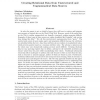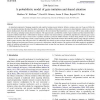1540 search results - page 308 / 308 » Deceptive agents and language |
AI
2007
Springer
13 years 5 months ago
2007
Springer
In this paper, we model multi-agent events in terms of a temporally varying sequence of sub-events, and propose a novel approach for learning, detecting and representing events in...
JAIR
2008
13 years 5 months ago
2008
In order for agents to act on behalf of users, they will have to retrieve and integrate vast amounts of textual data on the World Wide Web. However, much of the useful data on the...
NN
2006
Springer
13 years 5 months ago
2006
Springer
An important component of language acquisition and cognitive learning is gaze imitation. Infants as young as one year of age can follow the gaze of an adult to determine the objec...
AAI
2002
13 years 5 months ago
2002
In this paper, we discuss scripting tools that aim at facilitating the design of web-based interactions with animated characters capable of affective communication. Specifically, ...
ICMI
2010
Springer
13 years 3 months ago
2010
Springer
Traditionally listener response prediction models are learned from pre-recorded dyadic interactions. Because of individual differences in behavior, these recordings do not capture...


